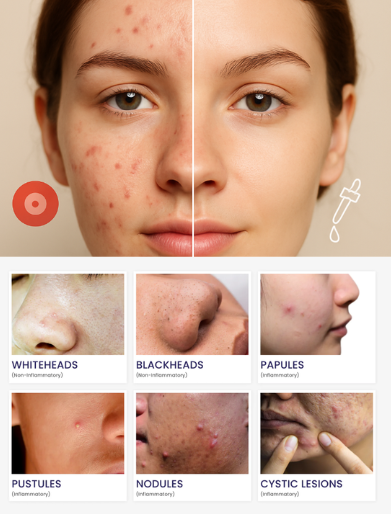
Acne isn’t just an occasional nuisance that appears out of nowhere. It’s a skin condition with distinct reasons behind its occurrence. Many of us, frustrated with stubborn breakouts, try every new product on the market hoping for a quick fix. Unfortunately, this trial-and-error approach often makes things worse. Let’s dive deep into why acne occurs, its different types, and how you can treat it effectively.
Why Do You Get Acne?
Acne develops when hair follicles under the skin become clogged. Excess oil from overactive sebaceous glands, dead skin cells, bacterial infections, and dirt all contribute to blocked pores. When these pores become inflamed, they cause painful breakouts, known as inflammatory acne. When the pores are clogged but not inflamed, they form non-inflammatory acne, which doesn’t hurt but can still affect your skin’s appearance.
It’s important to remember that acne can appear on any skin type—oily, combination, or even dry skin. Understanding this is the first step toward an effective treatment plan.
6 Major Types of Acne
Acne isn’t one-size-fits-all. It falls into six primary categories:
1. Whiteheads (Non-Inflammatory)
Whiteheads occur when pores are clogged with bacteria, oil, and dead skin cells. They’re generally pain-free and appear as small white bumps on the skin.
2. Blackheads (Non-Inflammatory)
Blackheads form when open pores trap dirt, oil, and sebum. The dark color isn’t dirt—it’s oxidized oil, and these spots are typically non-painful.
3. Papules (Inflammatory)
Papules develop when clogged pores inflame the hair follicles. They’re red, tender bumps but don’t contain visible pus.
4. Pustules (Inflammatory)
The next stage after papules, pustules are inflamed acne lesions filled with pus. They can cause noticeable pain and discomfort.
5. Nodules (Inflammatory)
Nodular acne forms deep under the skin. These red, painful bumps can last weeks and require specialized treatment.
6. Cystic Lesions (Inflammatory)
Cystic acne is the most severe and painful type, deeply rooted under the skin. It can damage tissue layers, making it crucial not to ignore.
Note: Acne affects both teenagers and adults. Teenagers often experience cystic acne in the T-zone (forehead, nose, chin), while adults may see breakouts around the jawline and chin, with severity varying based on the underlying cause.
Video : My Evidence-Based Skincare Routine
Skincare Tips for Acne-Prone Skin
According to Dr. Geetika Mittal Gupta, Celebrity Cosmetic Dermatologist and Founder of ISAAC, following a targeted skincare regimen can clear acne faster. Here’s a simple, effective routine:
1. Use a Mild, Sulfate-Free, Non-Comedogenic Cleanser
A clean face prevents microbial growth. Wash your face twice daily with a cleanser containing acne-fighting ingredients like Zinc PCA. Avoid sulfates and harsh chemicals that clog pores or irritate the skin.
2. Apply an Alcohol-Free Toner
Toners remove leftover dirt and makeup while balancing skin pH, a key factor in preventing breakouts. Alcohol-based toners dry the skin, which can worsen acne, so choose alcohol-free options.
3. Use an Antioxidant Serum
Serums rich in antioxidants and peptides help heal acne lesions, reduce inflammation, and combat early signs of aging. They nourish your skin deeply, promoting overall skin health.
4. Moisturize with Lightweight Formulas
Never skip moisturizer, even if your skin is oily. Opt for lightweight, non-greasy, non-comedogenic options with ingredients like salicylic acid, niacinamide, aloe vera, tea tree oil, or ceramides. These maintain hydration and help control sebum production.
5. Always Apply Sunscreen
Sunscreen prevents post-acne marks and pigmentation caused by sun exposure. Use a broad-spectrum, non-comedogenic sunscreen to protect sensitive, acne-prone skin.
Topical Treatments That Speed Up Acne Healing
Certain bio-active ingredients in topical treatments work wonders by targeting inflammation and controlling oil production.
1. Salicylic Acid
Salicylic acid is a beta hydroxy acid (BHA) that penetrates pores, removing dead skin cells and debris. It prevents whiteheads, blackheads, and pustules while soothing redness and inflammation.
2. Niacinamide
Niacinamide is a versatile option for all skin types. It calms irritation, balances oil production, and strengthens the skin barrier. Use concentrations of 3–5% for optimal acne healing.
3. Specialized Vitamin C (SAP)
Sodium Ascorbyl Phosphate (SAP) is a gentle form of Vitamin C for acne-prone skin. It boosts collagen, improves elasticity, reduces pigmentation, and heals acne without causing irritation.
Advanced Treatments for Stubborn Acne
While topical treatments are effective, some cases may require medical interventions.
Lasers and Light Therapy
Laser treatments target acne bacteria and reduce oil production. While effective, they may cause temporary redness or inflammation, so consult a dermatologist first.
Chemical Peels
Peels remove damaged skin layers using glycolic acid or other compounds. They smooth the skin but require sunscreen and careful post-treatment care to prevent side effects like redness or fungal infections.
Sun Protection: A Must
Even with acne, never skip sunscreen. UVA and UVB rays can darken scars, aggravate inflammation, and worsen pigmentation. Ultra-light, non-comedogenic sunscreens are ideal for sensitive, acne-prone skin.
Video : Ultimate Acne Guide: Causes, Types, and Treatments for Clear Skin
Conclusion
Acne may feel frustrating, but it’s manageable with the right knowledge and routine. Understanding the causes and types of acne allows you to select treatments effectively. Combine a consistent skincare regimen with topical treatments and sun protection, and you’ll notice remarkable improvements in your skin. Remember, patience and consistency are key—your clear, smooth skin journey begins with small, daily steps that protect, nourish, and heal.


